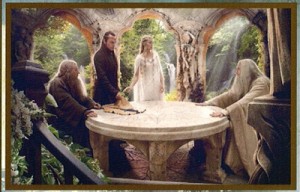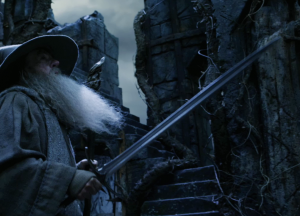Things we know (plus a few immediate inferences):

• From the footage shown at CinemaCon, we know that Gandalf presents a Morgul-blade to Elrond, Galadriel, and Saruman (but not Radagast) at a White Council meeting in Rivendell, and they debate its significance. We can easily infer that Gandalf has initially shown the blade to Elrond upon his arrival at Rivendell, and that the Council has subsequently been summoned.
• In the same scene, we learn that at some point in the past, the Witch-king and the rest of the Nazgûl had been entombed / imprisoned by the Dúnedain, in crypts protected by powerful spells. One might ask why the Dúnedain didn’t simply destroy the Nazgûl, and the clear answer is that they must have tried and failed—and so sometime in the trilogy we’re likely to see a flashback to this, and learn the origin of the belief that “no man can kill” the Witch-king.
• Again from CinemaCon, we learn that Gandalf and Radagast meet at the tombs, investigate them and find them empty—unambiguous evidence that Sauron has returned, because only he could break the spells put there. Entombing the Nazgûl strikes me as the boldest of all of Jackson’s changes to Tolkien, and it seems clearly motivated by the need for such an unambiguous sign, one that does not involve Gandalf going to Dol Guldur and seeing Sauron himself (as he does in the book). When this was screened, the first movie was going to continue much further. Since this scene must be the conclusion to the investigation of Sauron’s return and begin the sequence leading to the Battle of Dol Guldur, it now seems very likely that we won’t see it this December.
• From the figurine character biographies, we know that the company encounters an apparently resurrected Azog (the orc captain killed long ago at the battle of Azanulbizar), and that Gandalf regards this as a clue as to the nature of the evil that dwells in Dol Guldur. This tells us that the film emphasizes Sauron’s powers of necromancy.
Things we don’t know:

• On a possibly related note, why was Gandalf in Dol Guldur many years previously, where he encountered mad Thráin and got the map of Erebor and the key? In the book, Gandalf was on a successful reconnaissance mission to determine whether the Necromancer was in fact Sauron, as long suspected.
• Where does Gandalf get the Morgul-blade?
• Who could possibly have lost the Morgul-blade? It certainly wasn’t lost by one of the Nazgûl.
• Why is Radagast absent from the White Council meeting? (In the book, he doesn’t seem to be a member, but you’d want to include him in the movie, it seems clear.)
• If giant spiders attack (and presumably destroy) Rhosgobel, where does Radagast spend the rest of the trilogy?
• Is there any reason for introducing a giant spider attack before the dwarves get to Mirkwood, other than the coolness thereof?
• Where are the tombs of the Nazgûl, and when do Gandalf and Radagast investigate them?
• Why is Gandalf missing during much or most of the journey from Hobbiton to the Trollshaws? (Check out the scenes of running dwarves in trailer two.)


